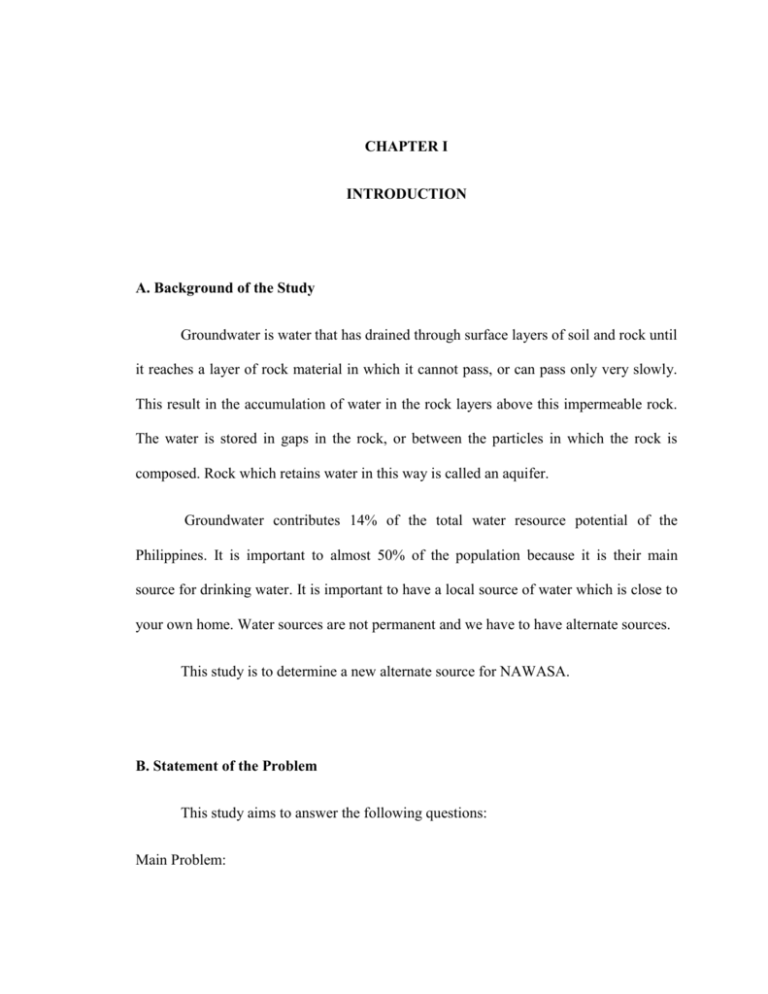CHAPTER I
advertisement

CHAPTER I INTRODUCTION A. Background of the Study Groundwater is water that has drained through surface layers of soil and rock until it reaches a layer of rock material in which it cannot pass, or can pass only very slowly. This result in the accumulation of water in the rock layers above this impermeable rock. The water is stored in gaps in the rock, or between the particles in which the rock is composed. Rock which retains water in this way is called an aquifer. Groundwater contributes 14% of the total water resource potential of the Philippines. It is important to almost 50% of the population because it is their main source for drinking water. It is important to have a local source of water which is close to your own home. Water sources are not permanent and we have to have alternate sources. This study is to determine a new alternate source for NAWASA. B. Statement of the Problem This study aims to answer the following questions: Main Problem: 2 Which of the two water sources is more a sufficient water source for NAWASA? Sub-problems: 1) Is there a significant difference in the water samples’ Turbidity ORP PH level Mineral contents Abundance C. Hypotheses of the Study 1. There is no significant difference in the water sources’ turbidity 2. There is no significant difference in the water sources’ ORP 3. There is no significant difference in the water sources’ PH level 4. There is no significant difference in the water sources’ mineral contents D. Objectives of the Study This research aims to: 3 1. Determine which of the two water sources is a more sufficient source for NAWASA; 2. Determine the turbidity of both water sources; 3. Determine the PH level of both water sources; 4. Determine the mineral contents of both water sources; 5. Develop a simple and relatively cheap way to identify the water sources’ mineral contents. E. Significance of the Study This study was performed in order to identify a new/alternate local source for NAWASA. People living near the water sources can also benefit from this study. They will know if the water sources near them are sufficient sources for their personal use. Future researchers who want to get into details about local water sources as a sufficient water source for NAWASA could also benefit from this study by making this one of their references. F. Scope and Limitations of the Study This study is limited to the study two local water sources in Iligan City, the Kalubihon Spring and Agus. The researchers will only focus on the water sources’ 4 turbidity, ORP, Ph level and mineral contents. And the water samples are to be further studied in the laboratory to know the mineral contents of each water sources. The experiment was conducted during the School Year 2011 - 2012. G. Definition of Terms Aquifer s a wet underground layer of water-bearing permeable rock or unconsolidated materials (gravel, sand, or silt) from which groundwater can be usefully extracted using water well. ORP is a measure of the tendency of a chemical species to acquire electrons and thereby be reduced Ph level is a measure of the acidity or basicity of an aqueous solution. Pure water is said to be neutral, with a pH close to 7.0 at 25 °C (77 °F). 5 Spring it is any natural situation where water flows to the surface of the earth from underground. Thus, a spring is a site where the aquifer surface meets the ground surface





